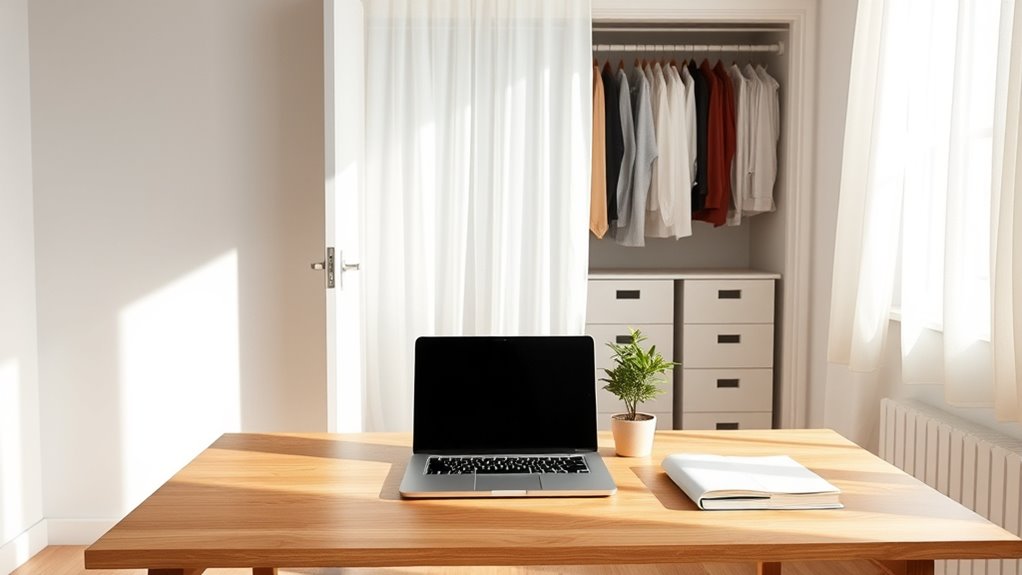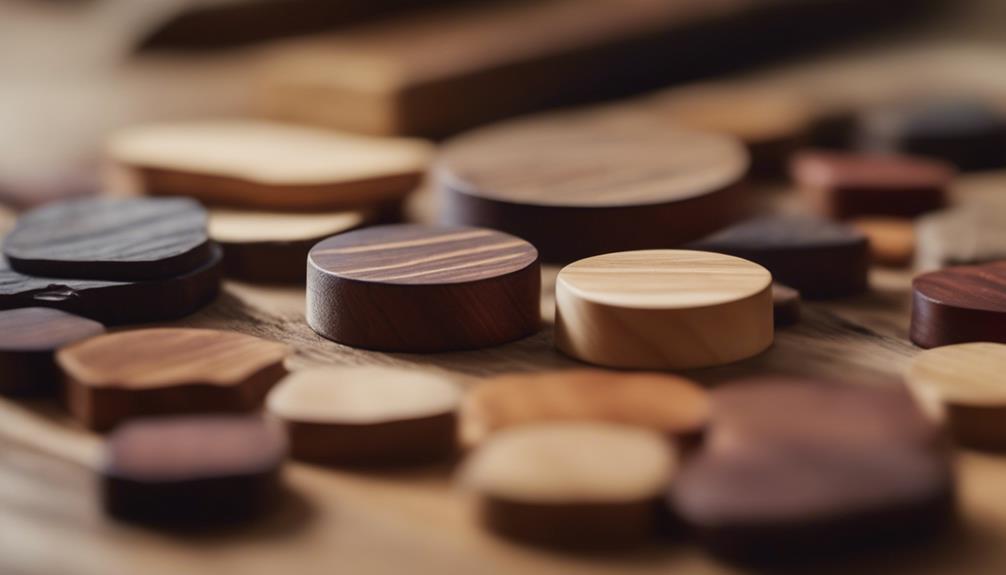To declutter your life, start by recognizing the benefits like reduced stress and increased focus. Assess your space and habits, identifying clutter hotspots and establishing clear goals aligned with your values. Break the process into small, manageable steps, focusing on high-impact areas first. Develop daily routines and stay mindful of possessions, regularly re-evaluating to maintain order. With consistent effort and a positive outlook, you’ll create lasting change—discover more ways to simplify as you go.
Key Takeaways
- Assess your current space and habits to identify clutter hotspots and understand your clutter patterns.
- Set clear, realistic decluttering goals aligned with personal values and desired outcomes.
- Break the process into small, manageable tasks, focusing on high-impact areas first.
- Establish daily routines and mindful practices to maintain organization and prevent future clutter buildup.
- Celebrate progress, stay flexible, and regularly re-evaluate to sustain a clutter-free and balanced life.
Recognize the Benefits of Decluttering
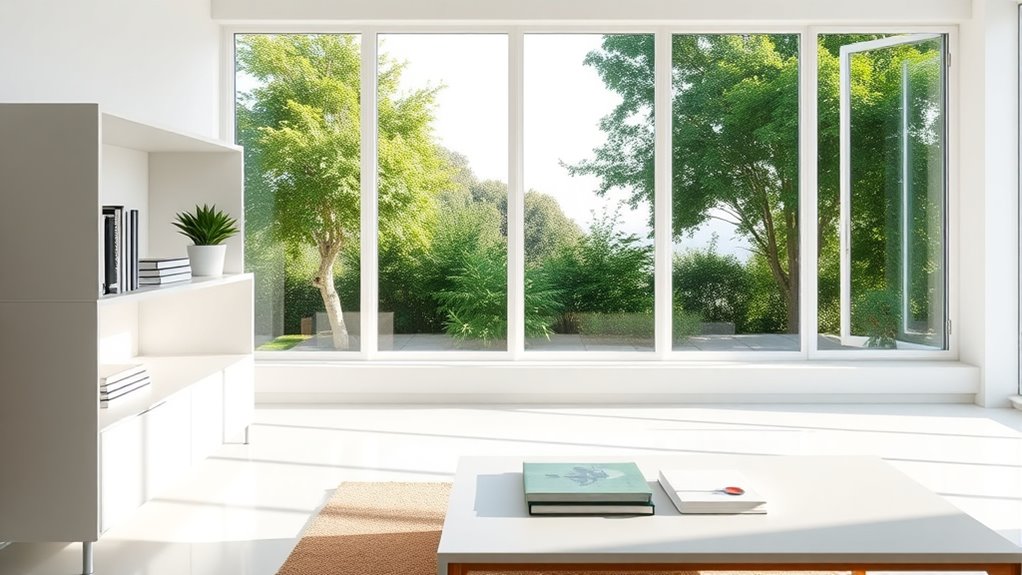
Recognizing the benefits of decluttering can motivate you to start and maintain an organized space. When you clear away clutter, you reduce stress and anxiety by removing overwhelming stimuli. A tidy environment lifts your mood, making you feel more positive and accomplished.
Decluttering reduces stress, lifts your mood, and creates a more positive, accomplished environment.
As you declutter, you boost your self-worth through each completed task, fostering emotional well-being and respect for your space. You’ll also notice a calming effect that promotes relaxation and mental clarity. Incorporating organized storage solutions can further enhance these benefits by making it easier to maintain your decluttered environment. Additionally, understanding the benefits of a tidy space can inspire ongoing commitment to organization.
Decluttering isn’t just emotional—it improves focus and productivity by minimizing distractions. It supports your physical health by enhancing air quality, safety, and sleep.
Plus, it saves time and money, making everyday tasks easier and reducing unnecessary expenses. Overall, embracing decluttering can transform your life into a more balanced, healthy, and efficient space. Additionally, practicing mindful decluttering strategies can help ensure you maintain these benefits over time.
Assess Your Current Space and Habits
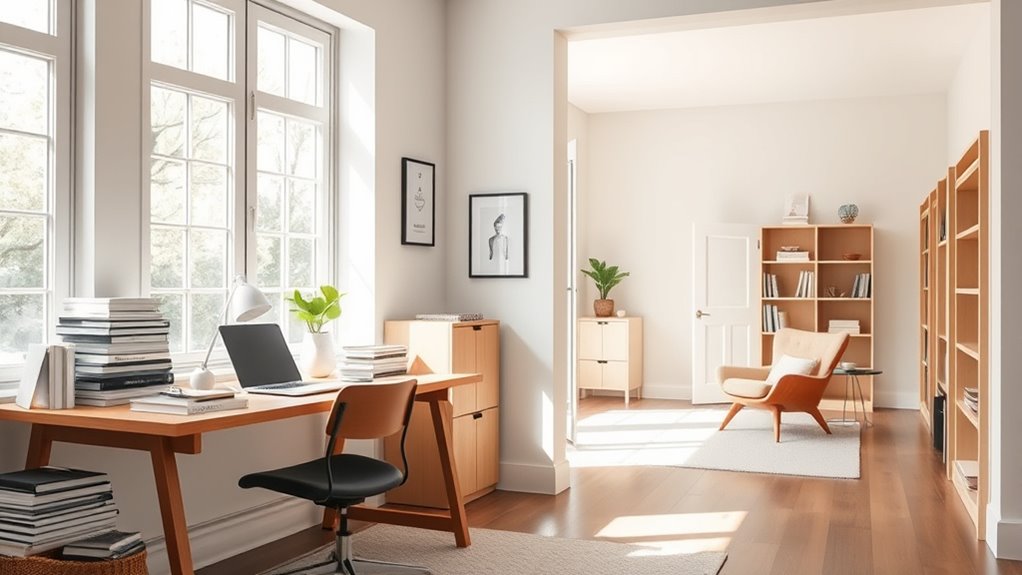
To effectively declutter, you need to start by understanding your current space and habits. Begin by identifying clutter zones—areas where clutter piles up most. Track which items you use daily and which sit ignored. Categorize similar items like books or kitchen utensils to see what you own. Additionally, consider how your storage solutions impact your ability to organize efficiently. Evaluate your storage solutions to spot inefficiencies. Document your progress with photos to compare before and after. Also, assess how your routines contribute to clutter; for example, leaving dishes overnight or impulse shopping. Recognizing your organizational methods can reveal which strategies are effective and which need adjustment. Consider your habits around tidying up regularly to prevent clutter from accumulating. Recognize patterns, such as busy times when clutter accumulates, and address digital clutter like emails or files. Understanding your clutter triggers can help you develop targeted strategies to minimize unnecessary accumulation, such as unnecessary purchases, making your decluttering efforts more efficient. This assessment provides a clear picture of what needs attention, making your decluttering efforts more targeted and effective.
Set Clear Goals for Your Decluttering Journey

Setting clear goals is essential to stay focused and motivated throughout your decluttering journey. Start by defining specific objectives, like optimizing storage or embracing minimalism. Knowing your reasons helps you stay committed, whether it’s reducing stress, boosting productivity, or improving living conditions. Think about how decluttering aligns with your personal values and lifestyle aspirations. Consider the impact on your time management and overall well-being, and use these benefits as motivation. Well-defined goals give you direction and make your progress measurable. Keep them realistic and achievable, setting deadlines to maintain momentum. Recognizing clutter signs can help you identify areas that need decluttering and stay motivated to remove unnecessary items. Being aware of disorganized spaces can motivate you to tackle clutter systematically. Understanding the emotional attachment to certain items can also assist in making more mindful decisions during decluttering. Developing a plan to address storage solutions can further streamline your efforts. Focusing on water-related clutter in your home, such as unused or forgotten items near sinks and tubs, can also be an effective way to reduce unnecessary clutter. Clear goals are your roadmap to a clutter-free, organized life.
Break Down the Decluttering Process Into Manageable Steps
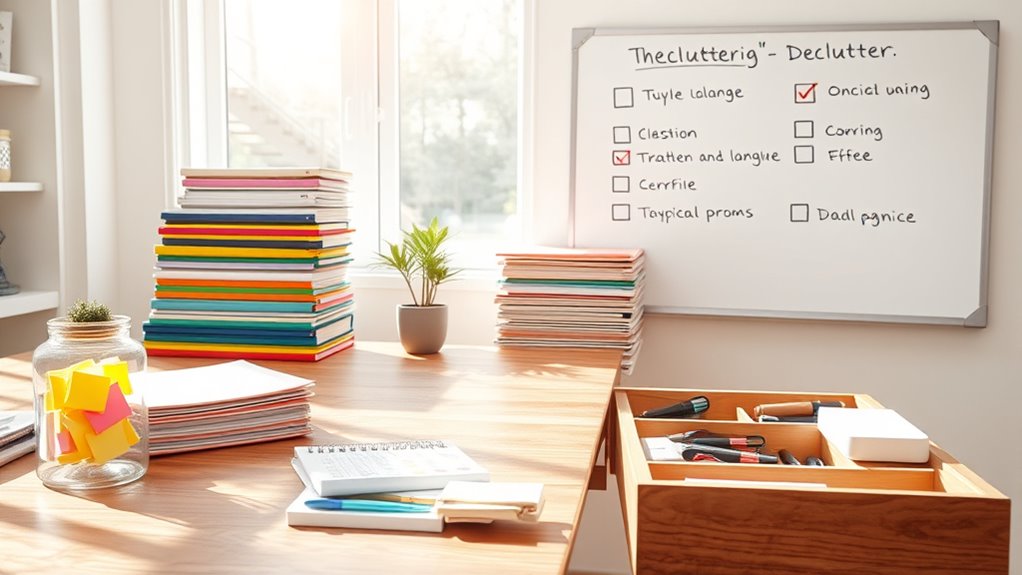
Breaking down the decluttering process into manageable steps makes the task less overwhelming and more achievable. Start by establishing a decluttering system with designated boxes for keep, donate/sell, discard, and recycle. Use clear labels to stay organized and sort items by category, not location, to see the full scope of clutter. Incorporating organization tools can further streamline your process and maintain tidiness. Tackle one area at a time, beginning with small spaces like a drawer, and set specific time blocks to stay focused. Progress tracking boosts motivation and highlights how each space improves your environment.
After completing each area, develop a maintenance plan—schedule regular reviews, follow a one-in-one-out rule, and use reminders. Breaking the process into steps keeps you motivated and makes decluttering feel more manageable.
Focus on High-Impact Areas First
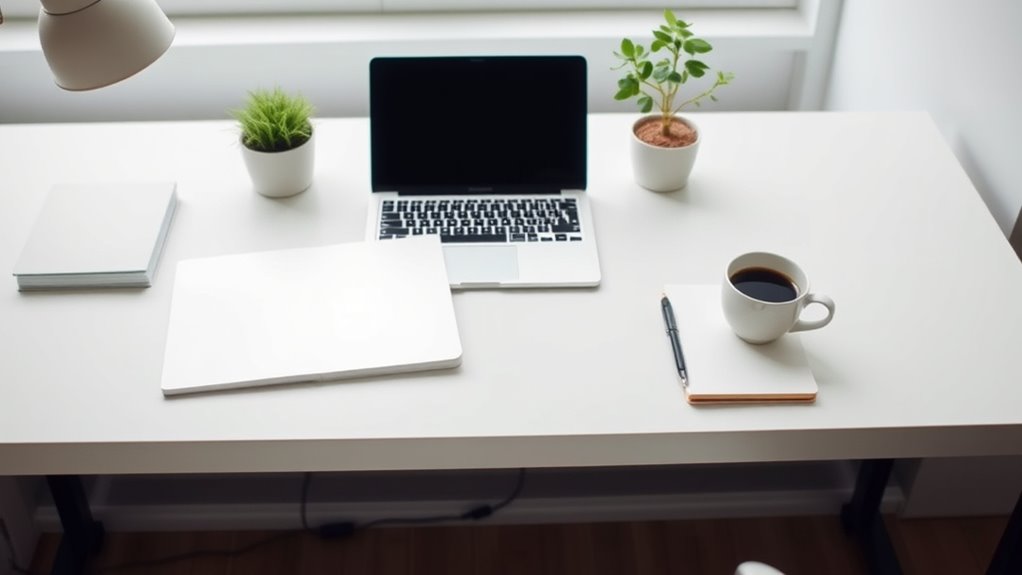
Focusing on high-impact areas in your home can accelerate your decluttering progress and make a noticeable difference quickly. Target spaces like the kitchen, bathroom, entryway, linen closet, and kids’ bedrooms, where clutter most affects daily life and visual appeal. Incorporating versatile use and organizing tools can further streamline these spaces for better functionality.
Clearing countertops, organizing drawers, and decluttering shelves not only improves functionality but also boosts motivation. These areas provide immediate visual results, creating a sense of accomplishment that encourages continued effort. Easy-to-make, appealing snacks like Garlic Herb Butter or Caprese Endive Boats can also serve as motivational rewards during your decluttering journey.
Tackling high-impact zones first also reduces feelings of overwhelm by showing tangible progress early on. Plus, decluttering key spaces can streamline routines, save time, and enhance the overall home environment. Incorporating efficient storage solutions, such as refrigerator organization, and understanding resources and training can further help maintain a tidy space over time.
Establish a Consistent Decluttering Routine
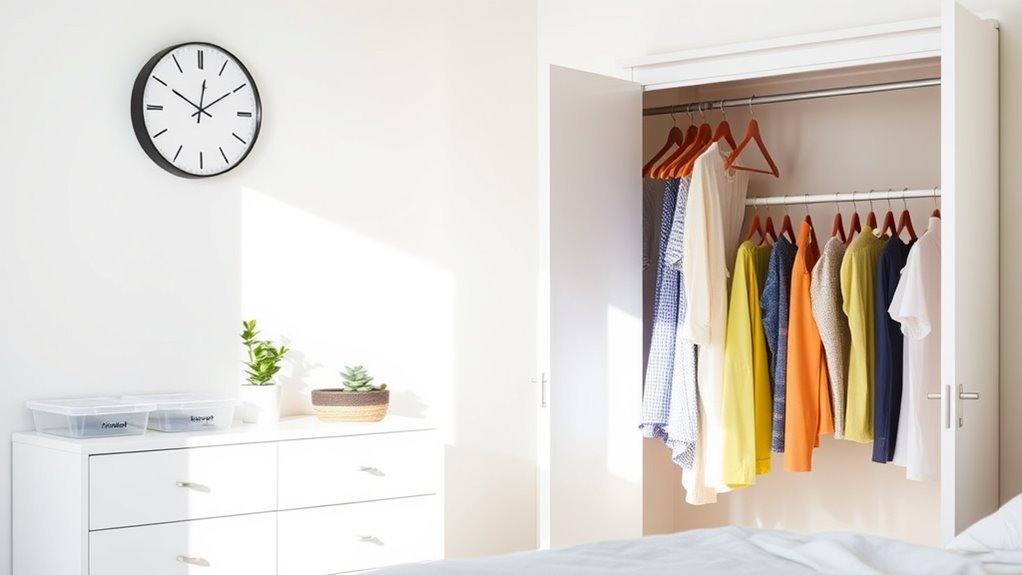
Establishing a consistent decluttering routine is key to maintaining an organized home over the long term. Start by setting realistic goals and breaking down tasks into small, manageable steps to prevent feeling overwhelmed. Incorporate effective skincare methods or motivational phrases to stay encouraged throughout your decluttering journey. Create a schedule that dedicates 10 to 15 minutes daily for decluttering, making it a part of your regular routine. Designate specific places for each item to keep your space orderly and reduce clutter. Use effective methods like the four-box or KonMari approach to guide your efforts. Make decluttering a habit by integrating it into daily activities, similar to brushing your teeth or showering. Understanding your personality traits can also help tailor your decluttering strategies to stay motivated and consistent. Additionally, fostering a digital-friendly environment at home can help prevent clutter from accumulating in the digital realm and streamline your physical space.
Incorporate Mindfulness and Re-evaluate Your Possessions
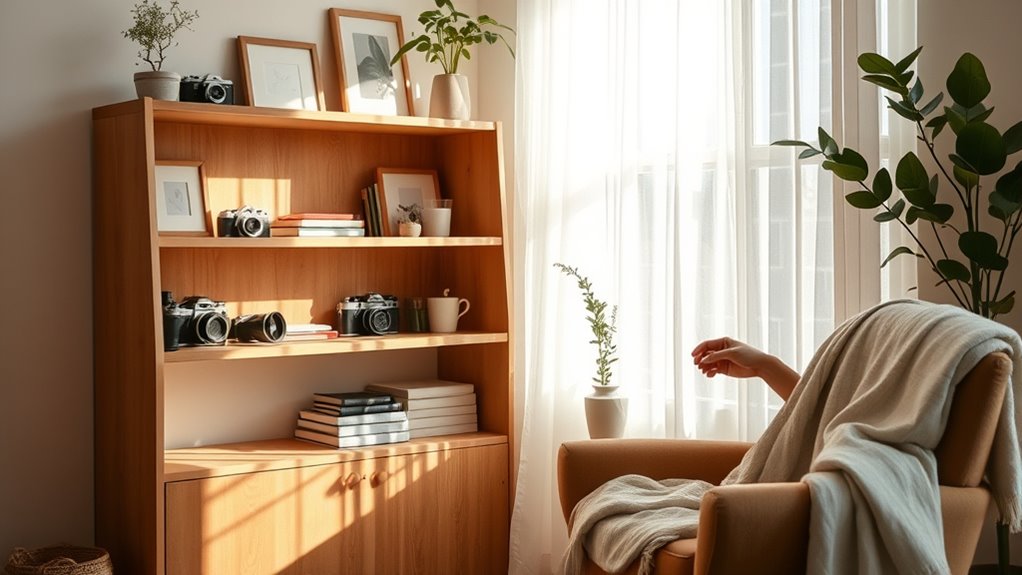
Building a mindful approach to decluttering helps you develop a deeper awareness of your possessions and their role in your life. Focus on gratitude by appreciating what you already have, fostering a positive mindset. Incorporate mindfulness techniques to stay present during each step of the process. Practice compassion by decluttering to create a more harmonious environment for yourself and others. Approach each item with mindfulness, handling it slowly and intentionally, paying attention to sensations, thoughts, and feelings. Assess each item’s true value by considering its utility and emotional significance, then decide whether to keep, donate, or discard. Let go of attachment to things that no longer serve you, emphasizing quality over quantity. This mindful re-evaluation simplifies your space and strengthens your connection to what truly matters, paving the way for a more intentional, clutter-free life.
Maintain Your Decluttered Environment Long-Term
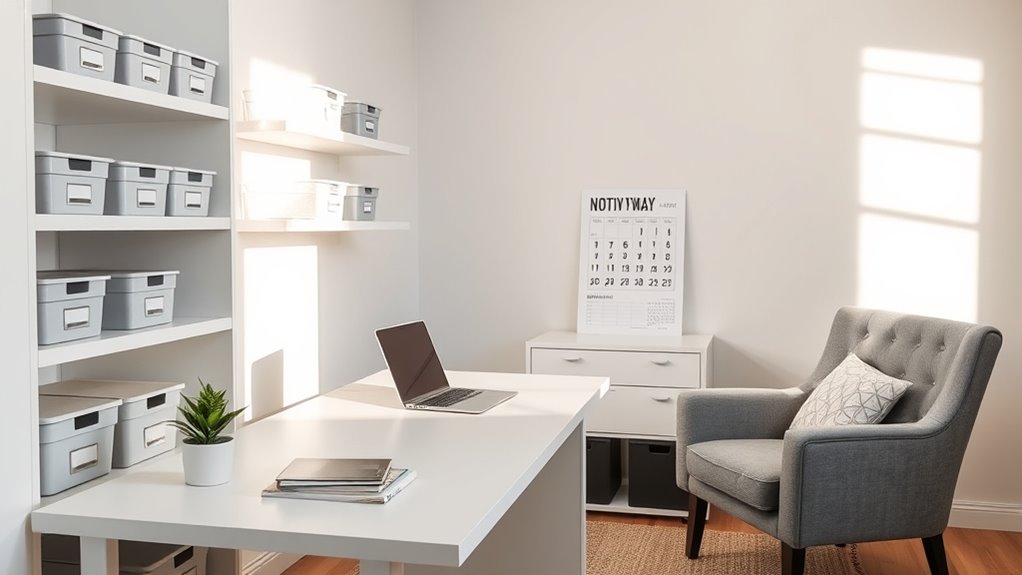
To keep your space clutter-free over time, consistency is essential. Break down your maintenance into manageable tasks, focusing on one room at a time to avoid feeling overwhelmed. Celebrate small victories to stay motivated and reinforce your progress.
Incorporate daily or weekly routines, such as spending 15 minutes tidying up or reviewing belongings, to make decluttering a habit. Use organizational systems and storage solutions to keep items accessible and neat.
Set boundaries to prevent clutter from returning and regularly review your possessions to ensure they still serve you. Involve family members to share responsibilities and foster a collective effort.
With consistent effort and clear boundaries, your decluttered environment will stay organized and peaceful long-term.
Embrace Your Progress and Adjust as Needed
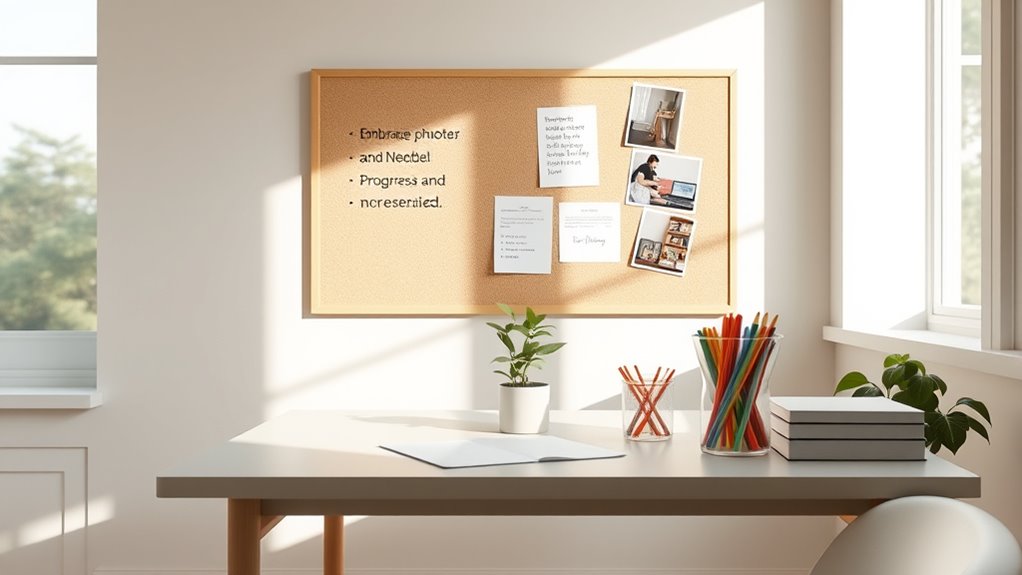
Embracing your progress means recognizing that decluttering is a journey of continuous improvement rather than perfection. You should focus on small wins and steady growth, understanding that setbacks are part of the process.
Set clear goals, like reducing stress or creating more space, and adjust them as your circumstances change. Be flexible with your strategies, adapting to new challenges or lifestyle shifts.
Celebrate your achievements, no matter how minor, and practice self-kindness to stay motivated. Remember, decluttering impacts your emotional well-being, so maintaining a positive mindset is key.
Regularly reflect on your progress and tweak your approach when needed. This ongoing process helps you build resilience, fosters clarity, and keeps you moving forward with purpose.
Frequently Asked Questions
How Do I Stay Motivated During a Long Decluttering Process?
Staying motivated during a long decluttering process can be tough, but you can do it. Focus on small wins to build momentum, celebrate each victory, and keep your goals clear.
Remind yourself of the benefits, like less stress and more space. Involve friends or family for support, and revisit your reasons regularly.
Be kind to yourself when setbacks happen, and stay flexible with your plan.
What Are Effective Ways to Handle Sentimental Items?
Sentimental stuff can seem stressful, but smart strategies make it simpler. Start by storytelling—share the significance behind each item to help decide if it stays or goes.
Consider creating digital copies to preserve memories without clutter. Select only the most meaningful pieces, and display or store them thoughtfully.
Set a schedule to revisit these favorites regularly, ensuring you honor memories without overwhelming your space or your heart.
How Can I Involve Family Members in Decluttering?
Involving family members in decluttering makes the process easier and more enjoyable. You can assign each person their own space, set clear rules, and turn tasks into fun activities like scavenger hunts or challenges.
Encourage teamwork by setting timers and celebrating small wins. This not only reduces the workload but also teaches responsibility, builds closer bonds, and keeps everyone motivated to maintain an organized home.
What Tools or Supplies Are Best for Organizing After Decluttering?
Imagine your space as a blank canvas—you need the right tools to bring order to chaos. You should use shelves, storage cubes, and drawer organizers to categorize and store items efficiently.
Label makers make sure everything has its place, while clear containers and under-bed storage maximize space. Collapsible stools and handheld vacuums keep cleanup easy.
With these supplies, you turn clutter into clarity, making your home organized and inviting.
How Do I Prevent Clutter From Accumulating Again?
To prevent clutter from coming back, you need to stay consistent with your routines. Regularly reassess your space, stick to the one-in, two-out rule, and assign designated spots for everything.
Be mindful of new purchases, avoid impulse buying, and limit digital clutter by organizing files and unsubscribing from unnecessary emails.
Maintaining these habits keeps your environment organized and clutter-free, making it easier to enjoy a tidy, stress-free space.
Conclusion
By decluttering, you open a clearer mind and a more peaceful space—your sanctuary. Remember, every item you let go of is a step toward freedom from chaos. Like pruning a tree, trimming your possessions allows your life to flourish. Stay consistent, re-evaluate, and celebrate your progress. Your journey isn’t just about a tidy space but about creating a life that feels lighter, brighter, and truly yours. The power to transform is in your hands.

